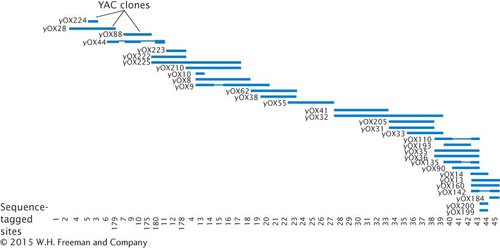Physical Maps
Physical maps are based on the direct analysis of DNA, and they place genes in relation to distances measured in number of base pairs, kilobases, or megabases (Figure 15.2). A common type of physical map is one that connects isolated pieces of genomic DNA that have been cloned in bacteria or yeast. Physical maps generally have higher resolution and are more accurate than genetic maps. A physical map is analogous to a neighborhood map that shows the location of every house along a street, whereas a genetic map is analogous to a highway map that shows the general locations of major towns and cities.

One of the techniques that has been used for creating physical maps is restriction mapping, which determines the positions of restriction sites on DNA. When a piece of DNA is cut with a restriction enzyme and the fragments are separated by gel electrophoresis, the number of restriction sites in the DNA and the distances between them can be determined by the number and positions of bands on the gel, but this information does not tell us the order or the precise location of the restriction sites. To map restriction sites, a sample of the DNA is cut with one restriction enzyme, and another sample is cut with a different restriction enzyme. A third sample is cut with both restriction enzymes together (a double digest). The DNA fragments produced by these restriction digests are then separated by gel electrophoresis, and their sizes are compared. Overlap in the sizes of the fragments produced by the digests can be used to position the restriction sites on the original DNA molecule. Although restriction mapping has been an important tool for creating physical maps in the past, the rapid, low-
CONCEPTS
Both genetic and physical maps provide information about the relative positions of and distances between genes, molecular markers, and chromosome segments. Genetic maps are based on rates of recombination and are measured in recombination frequencies. Physical maps are based on physical distances and are measured in base pairs.